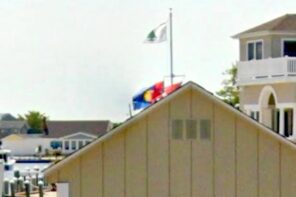There may be no New York City street more sensitive to attire than Bedford Avenue in Brooklyn.
On the north side of the Williamsburg Bridge, which crosses the East River to Lower Manhattan (an overpriced bastion of artists, ambitious émigrés, and wannabes), is the world capital of hipster fashion. Children and the elderly are nowhere to be seen, except as the remnants of the immigrant communities that have resisted selling to condo developers. “Normal” means skinny jeans, neon sunglasses, ironic tattoos, and something that is somehow shocking. On a warm Saturday fixed-gear bikes, the preferred mode of transportation, easily outnumber cars.
South of the bridge, however, Bedford passes through Williamsburg’s bustling, Yiddish-speaking Satmar Hasidic community, largely descended from Eastern European Holocaust survivors. The men wear long, black jackets and big, black hats—even bigger ones on the Sabbath. Married women cover their heads with wigs. Children, sidecurls running down their faces, pour out of yeshivas into yellow schoolbuses with Yiddish signage. Gray-bearded old men mutter prayers under their breath as they walk.
The Hasidim and hipsters, in their own way, both came to Williamsburg from a more hostile elsewhere in order to live—and dress—as they please. But now along Bedford Avenue a small war of religion may be brewing between strict, Hasidic Judaism and perhaps equally-strict hipster libertinism.
At the beginning of this month, New York City Department of Transportation workers sandblasted away the bike lanes painted on the Hasidic side of Bedford, between Flushing and Division Avenues. It came as the result of a decision made earlier in the year, seen by both communities as a move by Mayor Bloomberg to win over the Hasidim by placating, so to speak, their fashion sensibilities: a religious injunction not to look upon women who aren’t covered from head to toe.
The Bedford bike lane, a popular route from central Brooklyn to northern Williamsburg and the bridge, brought a wide variety of the borough’s cultural diversity through the heart of the Hasidic enclave. But the hipsters, who take their bikes as seriously as their Ray Bans, have led the fight to get it back.
All month, bicyclists have been taking the matter into their own hands. Within a week of the lanes’ removal, a team repainted them at night with spray cans, rollers, and stencils. The direct-action environmental organization Time’s Up! led a New Orleans-style funeral procession for the lane along Bedford on December 13. A week later came what promised to be the most daring of the protests: a topless “panty ride.”
It was sponsored by Candy Rain, “a lifestyle magazine for women that love d**ks,” according to Calisha Jenkins, who works for the magazine. She said in an interview while riding her bike, “They’re essentially moving it because they don’t want to look at girls dressed like sluts. And I want to dress like a slut.” Lead organizer Heather Loop, a 27-year-old bicycle messenger with a purple fixed-gear and a septum ring, added, “I feel like they’re forcing their beliefs on us. It’s in the Bill of Rights to not force your religion on anybody.”
The evening’s weather turned out to be especially hostile, with a snowstorm already underway, so all the cyclists remained fully clothed. Of the 40 or so present, at least half were journalists, disappointed to miss the prime photo-op of more-than-half-naked hipsters and bewildered Hasidim. Many rode with the activists as part-participant, part-observer. Trailing them, with lights flashing, was a police car and a van full of officers at the ready.
As she led the group along a route that included two passes up the embattled 14-block section of Bedford, Heather Loop insisted that they follow all traffic laws, so as to give the police no opportunity to shut down the ride. With a flock of bikes so large and so determined to stick together, this became difficult in practice, but no arrests or confrontations occurred.
Loop deliberately planned the event for sunset on Saturday to coincide with the end of the Sabbath in the hope, she said, that “they would all be coming out of their houses to see us standing up for what we believe in.” But the Williamsburg Hasidim continue the Sabbath until some time after sunset, well after the bicyclists had come and gone. Because of their observance, most of the handful of people out on the street wouldn’t answer questions about the protest.
Loop didn’t seem to notice. When asked, while waiting at a red light with dozens of bikes in jumbled formation behind her, what effect she thought the ride was having on the locals, she said, “I don’t know, I’m not really paying attention to them.”
There is some precedent for this clash of civilizations. In 2004, Harper’s magazine published a Hebrew prayer apparently targeting Williamsburg’s hipsters. “Please remove from upon us the plague of the artists,” it said, “so that we shall not drown in evil waters, and so that they shall not come to our residence to ruin it.” This sounded to many like a declaration of spiritual warfare against the encroachment of their new neighbors.
Just last year, when a sexy billboard for the TV show 90210 appeared over the Brooklyn-Queens Expressway, a busy Interstate that many of the Hasidim use on a daily basis, the community objected. It was around that time that discussion began about the Bedford bike lane, which was placed there by the city in 2007. While in official meetings, community leaders always cited concerns with traffic and safety, news articles usually drew attention to off-the-record complaints about proper attire. This, in turn, became the most commonly accepted explanation among bicycle activists for the lane’s removal.
“There’s nothing unsafe about bikes,” says Theo Angell, a 41-year-old artist who joined in the December 19 ride. “Bikes pose no threat to anyone.” He concluded that the lanes were removed “for basically religious reasons.”
Scratch an apparently religious reason, however, and there is often something more than sheer dogma beneath the surface. The “plague of the artists” prayer, for instance, is as much a reaction to Williamsburg’s skyrocketing rents as to invading interlopers. It includes a plea that God might strengthen community members “so that they can withstand this difficult test and so that they will not sell for the lure of money.” A sign on a Hasidic-owned building during that time said, “We need AFFORDABLE housing!”
After the the December 19 protest passed through the neighborhood, one Hasidic man who wouldn’t give his name said that blaming dress code for the removal of the bikes lane “is just bullshit.” He is disappointed with how his people have been portrayed in news reports about this issue and insists that safety was a genuine concern.
That’s what nearly everybody walking up and down Hasidic Bedford in daytime says as well. When asked directly about it, they concede that they believe many cyclists to be inappropriately dressed, even while insisting that that alone was not reason enough to remove the lane.
An ambulance driver said that there had been a lot of accidents with children, though he had never personally seen one. A man named Moshe, however, said he did once see a child hit by a bike. “It’s terrible,” he said. A yeshiva school bus driver complained, in an extended conversation aboard his bus, “bikes don’t obey any laws.” He doesn’t think religious concerns about clothing were the motivating force at all. “It is a free country,” he said.
“The problem is how they ride on it,” added a Hasidic man named Abraham while checking his mailbox on Bedford. “They don’t care about the kids.” Both a bicyclist and a school bus driver, he enjoyed using the bike lane but now is glad, for the sake of safety, that it is gone.
Bicyclists, meanwhile, contend that Hasidic drivers are particularly hostile to them on the roads. “They treat bikers horribly in that neighborhood,” said Heather Loop. The school bus drivers say that they have to turn into the bike lanes to make sure cyclists stop while they load and unload children. “So you’re going to use your vehicle as a weapon against a cyclist?” demands Heather Loop. “How just is that?”
Bedford Avenue has become the site of spiraling road rage that has consumed both sides. And religion, saddled with clothing, doesn’t make it any easier.
For whatever deep conviction the Hasidic community might bring to opposing a bike lane, cyclists bring some of their own. The statement Heather Loop wanted to make with her panty ride, she said, was that removing the lane won’t make the cyclists go away. “Even if there isn’t a bike lane, I’m going to continue to ride Bedford.” Brooklyn resident Tai Uhlmann added, “We’re all still going to ride, it’s just going to be more dangerous.”
Uhlmann, who took part in the protest despite being pregnant, gave voice to a reason why bicycling is a matter of principle to many cyclists. “With the way the world is going,” she said, “when we’re trying to be more environmentally conscious, to not encourage biking and make it safe for people to bike is unfortunate.” A 23-year-old “Jane of all trades extraordinaire,” who goes by xxLylaDurdeNxx on Candy Rain, gave other reasons too. She wore rubber breasts on her chest and spoke of her bicycle in poetic cadences. “Zero emissions on this thing. I’m not going to kill somebody on this thing. I’m working my fat ass out on this thing. It’s good work. Cleaner city, prettier city. If nobody’s gotten on a bike in this city, it’s a great feeling, I recommend it.”
The bicycle advocacy organization Transportation Alternatives is eager to keep the respective convictions of both hipsters and Hasidim from turning into a confrontation that could harm the chances of bike lane initiatives elsewhere. TA executive director Paul Steely White told Gothamist, a New York City blog, “Rhetoric or acts that pit neighbors against one another are not just irrelevant to this discussion, they are flat-out offensive.” He opposed Heather Loop’s proposed topless protest.
White’s organization works not only to advance cyclists’ causes but to change how they ride as well. One of its projects is a handbook called “Biking Rules!,” which includes a “Street Code” for responsible bicycling. “There is not a single community board meeting about bike lanes where cyclist behavior is not an issue,” said TA communications director Wiley Norvell. They believe that cyclists should work in a spirit of cooperation with neighborhoods, not confrontation.
But xxLylaDurdeNxx insisted their protest wasn’t meant to antagonize. “This isn’t a war. The issue is about getting a bike lane. That’s it. It’s not a war about beliefs or ideas,” she said, standing beside Loop and talking to reporters before the ride. “We all live here together. We’ve got to try and not get murdered together.”




